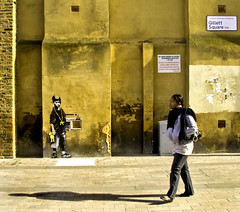Jumping a fence at night with paint and supplies in hand - the destination is a wall that, in your imagination, is a public gallery. Cops and escape are much on your mind. So is the history of art, meaning Banksy and Shepard Fairey and a million anonymous hobos, dispossessed youths and anarchist painters.
You have to be young or rebelliously old to enjoy the ramifications of graffiti.
For most people, graffiti is like, so 80's. That means one of 2 things: they might Love the 80's, in which case graffiti gets a free ride. Or they may see street art as hideously over-exposed. If you're Republican, graffiti has little chance of approval no matter What the perspective.
But graffiti has revivified itself stylistically through stencil and wheat paste poster modes. Indeed, Shepard Fairey's "Hope" piece for Obama has given poster graffiti a very positive cachet for many people - most of them Democrats, to be sure.
In graffiti the classics include:
* Roman and Greek examples
* historic hobo symbols
* "Kilroy was here," WWII style.
* "Dick Nixon before he dicks you," 70's anti-Vietnam war style.
* Berlin Wall anti-communist writing.
* NYC train wildstyle tagging; associated w hip-hop culture.
* full-scale satiric paintings a la Banksy (see illus above).
* Jean-Michel Basquiat-style, NYC, 80's.
* Keith Haring-style, NYC, 80's.
* Commercial work as sponsored by Adidas and Sony.
* As seen in video games.
* Sao Paulo surreal.
* Wheat paste and Sticker art.
* Stencil art.
Classic graffiti has the spirit of anarchy.
From Wikipedia:
Terrance Lindall, an artist and executive director of the Williamsburg Art and Historic Center, said regarding graffiti and the exhibition:[52]
"Graffiti is revolutionary, in my opinion," he says, "and any revolution might be considered a crime. People who are oppressed or suppressed need an outlet, so they write on walls—it’s free."
A 2006 exhibition at the Brooklyn Museum displayed graffiti as an art form that began in New York's outer boroughs and reached great heights in the early '80s with the work of Crash, Lee, Daze, Keith Haring and Jean-Michel Basquiat.
The developments of graffiti art which took place in art galleries and colleges as well as "on the street" or "underground", contributed to the resurfacing in the 1990s of a far more overtly politicized art form in the subvertising, culture jamming or tactical media movements.
In most countries, graffiti art remains illegal in many forms except when using non-permanent paint. Since the 1990s a growing number of artists are switching to non-permanent paints for a variety of reasons -- but primarily because is it difficult for the police to apprehend and for the courts to sentence or even convict a person for a protest that is as fleeting and less intrusive than marching in the streets. In some communities, such impermanent works survive longer than works created with permanent paints because the community views the work in the same vein as that of the civil protestor who marches in the street -- such protest are impermanent but effective nevertheless.
The British street artist Banksy has become one of the world's pre-eminent practicioners and success stories. Please read about him by clicking here.
Thursday, August 20, 2009
Subscribe to:
Post Comments (Atom)





No comments:
Post a Comment